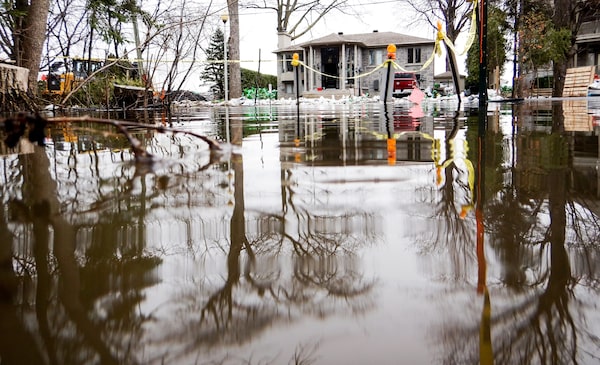
A house surrounded by floodwater is seen in the Ile-Bizard borough of Montreal, on May 1, 2018.Paul Chiasson/The Canadian Press
Rob Wesseling is president and CEO of The Co-operators Group Limited. Don Iveson is the former mayor of Edmonton.
Climate change is upon us, Canada. The past several years of devastating disasters and losses because of extreme weather have exposed our vulnerability. This is not just a problem of the future or of far-off places. It’s disrupting families, communities and our entire economy today.
Clearly, we need to invest in climate resiliency – but who will pay for it?
We are just weeks away from the federal budget announcement, which will be the first since the devastating floods that inundated British Columbia and Newfoundland in late 2021. With these events so fresh in our minds and consultations to shape the development of Canada’s National Adaptation Strategy now under way, we should expect the budget to add to the $1.4-billion already committed for disaster mitigation and adaptation in 2021.
Further resources to get ahead of climate change and prevent disasters would be a welcome development. There is a strong case to be made that each dollar invested in disaster-prevention strategies can save six dollars while creating jobs in the process, according to the Federation of Canadian Municipalities. With the Parliamentary Budget Officer warning that the federal cost of disasters will rise to more than $5-billion a year unchecked, we will need every penny saved by getting strategic about prevention.
But federal funds supporting disaster mitigation and adaptation will only bring us so far. The scale of the challenge is likely beyond what governments alone can pay for. Estimates of the costs of adapting to the increasing risks associated with a changing climate are in the tens of billions, if not more. Against all the other pressures facing Canadians, we cannot responsibly ask the taxpayers to carry the full financial burden of making our country more resilient.
That’s why private investors will surely need to play a role.
Canada can be a leader on energy security
Canada needs a blueprint for a green skills revolution
Fortunately, there is a lot of climate-concerned capital out there. In the lead-up to the COP26 climate conference last November, former Bank of Canada and Bank of England governor Mark Carney announced that banks, insurers, pension funds and other institutional investors with more than $130-trillion in assets had committed to align their portfolios with net-zero emissions by 2050.
These commitments reflect a broad societal consensus for climate-change mitigation by regulating and pricing greenhouse gas pollution. The time is now upon us to awaken a broad societal consensus on adaptation and prevention. We need to immediately mobilize massive investment in community resilience. Even in the most optimistic scenarios where we limit warming to just 1.5 C above preindustrial levels, we must harden against the more severe risks that lie ahead.
The question will be, how much of that $130-trillion in capital will be invested in adaptation and resilience? The answer may well lie in collaboration between governments and investors.
Municipalities are already at the forefront of these efforts. They build and maintain 60 per cent of public infrastructure in Canada. And perhaps even more importantly, our communities are also on the front lines of the impact. They will benefit tangibly from the investments, not just financially, but in terms of environmental resilience and emotional peace of mind.
When repeated flooding from severe storms hit Edmonton’s aging sewer system, weaknesses were exposed, and citizens demanded action. With the aid of sophisticated mapping and analytics, the city and EPCOR (Edmonton’s municipal utility crown corporation) were able to effectively design and prioritize a $1.6-billion package of flood defences now under construction. That will protect hundreds of thousands of households and businesses over time in Edmonton. But we need to scale this kind of work across the country and find ways to accelerate it where it’s already happening.
There are achievable, immediate solutions all around us. Levees to be repaired and raised. Firebreaks to be built in wildfire prone areas. Flood-buffering wetlands to restore. Sewer upgrades in municipalities across the country. Upgrades to facilities and infrastructure to make them more resilient to extreme heat and cold. In other words, there is more work than money on the table, and we need to muster enormous creativity, partnership and investment to rise to this challenge.
The tricky part is that the benefits of resiliency investments will be difficult to pin down. Some accumulate nationally, some locally, some publicly and some privately. The solution lies in creative and committed multistakeholder collaboration – across public and private sectors, and across all orders of government, including Indigenous leadership. By taking action together, property values can be protected, insurance costs can be more affordable and public costs of cleaning up disasters can be contained.
This means institutional investors and their managers should explore how they can invest in our infrastructure and communities. Insurers, in particular, can add sophisticated risk-based analysis to ensure that investments make efficient use of scarce resources. Municipalities should examine their priority resilience projects and consider how they might collaborate with insurers, investors and other actors to prevent losses and protect their communities.
The federal and provincial governments should consider what role they can play in facilitating these collaborations and investments, and what regulatory and policy barriers might need to be removed.
Canada must act boldly today to improve our resiliency against climate change, which is already here and poised to worsen. We also need to strengthen our deteriorating natural and built infrastructure, our economy and supply chains, and our communities.
Boldest of all, we’ll need to work together. Complex problems demand collaborative solutions. This will require unprecedented partnerships. We urge the federal government to use Budget 2022 to prioritize policy and investment that can protect the future of all Canadians.
Your time is valuable. Have the Top Business Headlines newsletter conveniently delivered to your inbox in the morning or evening. Sign up today.